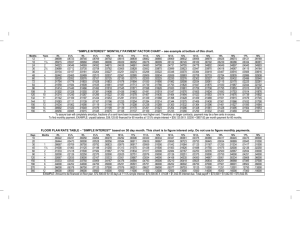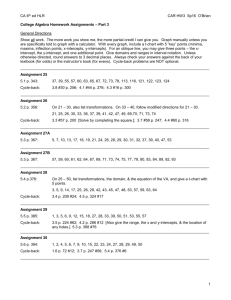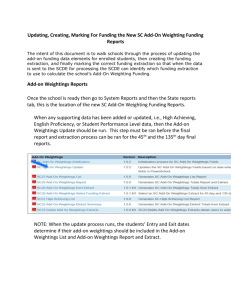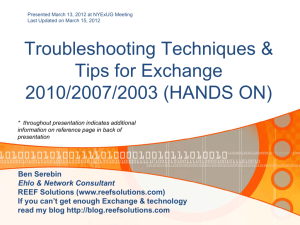Commercial Development of LTE-Advanced Applying Advanced C
advertisement
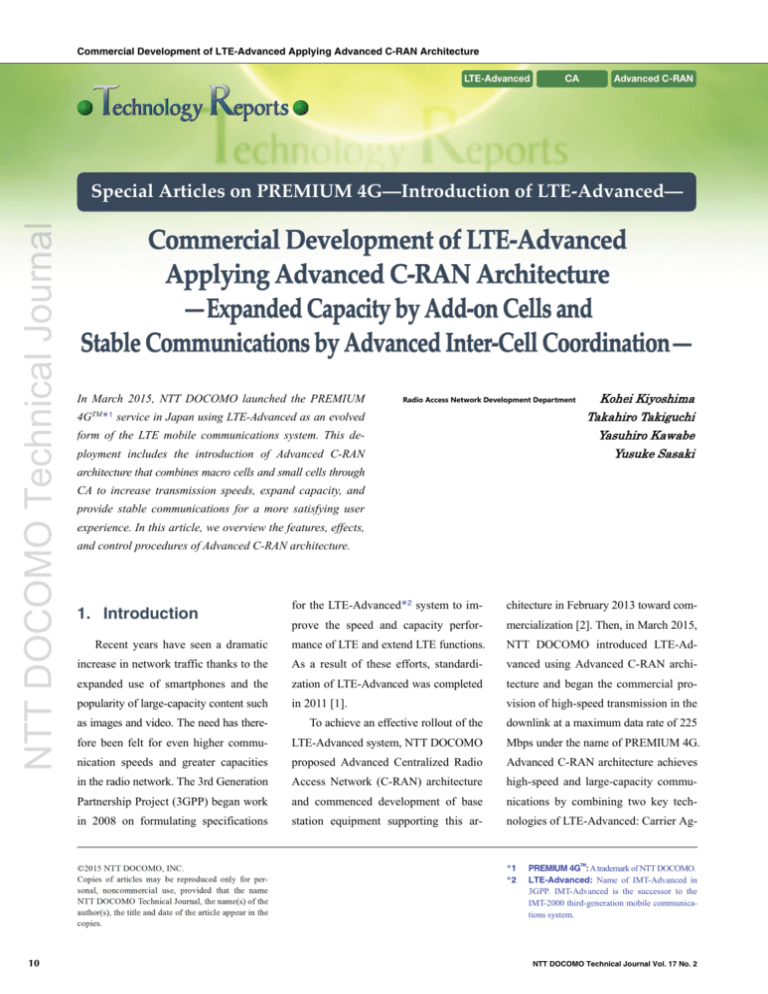
Commercial Development of LTE-Advanced Applying Advanced C-RAN Architecture LTE-Advanced CA Advanced C-RAN NTT DOCOMO Technical Journal Special Articles on PREMIUM 4G―Introduction of LTE‐Advanced― In March 2015, NTT DOCOMO launched the PREMIUM form of the LTE mobile communications system. This deployment includes the introduction of Advanced C-RAN Kohei Kiyoshima Takahiro Takiguchi Yasuhiro Kawabe Yusuke Sasaki architecture that combines macro cells and small cells through CA to increase transmission speeds, expand capacity, and provide stable communications for a more satisfying user experience. In this article, we overview the features, effects, and control procedures of Advanced C-RAN architecture. for the LTE-Advanced*2 system to im- chitecture in February 2013 toward com- prove the speed and capacity perfor- mercialization [2]. Then, in March 2015, Recent years have seen a dramatic mance of LTE and extend LTE functions. NTT DOCOMO introduced LTE-Ad- increase in network traffic thanks to the As a result of these efforts, standardi- vanced using Advanced C-RAN archi- expanded use of smartphones and the zation of LTE-Advanced was completed tecture and began the commercial pro- popularity of large-capacity content such in 2011 [1]. vision of high-speed transmission in the 1. Introduction as images and video. The need has there- To achieve an effective rollout of the downlink at a maximum data rate of 225 fore been felt for even higher commu- LTE-Advanced system, NTT DOCOMO Mbps under the name of PREMIUM 4G. nication speeds and greater capacities proposed Advanced Centralized Radio Advanced C-RAN architecture achieves in the radio network. The 3rd Generation Access Network (C-RAN) architecture high-speed and large-capacity commu- Partnership Project (3GPP) began work and commenced development of base nications by combining two key tech- in 2008 on formulating specifications station equipment supporting this ar- nologies of LTE-Advanced: Carrier Ag- ©2015 NTT DOCOMO, INC. Copies of articles may be reproduced only for personal, noncommercial use, provided that the name NTT DOCOMO Technical Journal, the name(s) of the author(s), the title and date of the article appear in the copies. 10 Radio Access Network Development Department 4GTM*1 service in Japan using LTE-Advanced as an evolved *1 *2 PREMIUM 4GTM: A trademark of NTT DOCOMO. LTE-Advanced: Name of IMT-Advanced in 3GPP. IMT-Advanced is the successor to the IMT-2000 third-generation mobile communications system. NTT DOCOMO Technical Journal Vol. 17 No. 2 gregation (CA) and Heterogeneous Net- and small tion equipment and decreasing facility also being studied as a basic architecture cell* added to that area (hereinafter investment. NTT DOCOMO has been mobile referred to as an “add-on cell”). CA operating C-RAN architecture since communications system now attracting requires coordination between cells that 2003 [5]. Furthermore, by leveraging attention throughout the world [3]. In a terminal is to be simultaneously con- the features of this C-RAN architecture this article, we overview the features, nected to, and as a result, specifications and adopting a new architecture that effects, and control procedures of LTE- dictate that the same base station be accommodates a macro cell and multiple Advanced based on Advanced C-RAN used to control those cells. Consequently, add-on cells in the same baseband pro- architecture. to increase capacity and improve sta- cessing unit, flexible coordination be- bility through add-on cells, macro cells tween a macro cell and add-on cells and add-on cells installed at different through CA has become possible. This points must be controlled by the same new architecture is called Advanced C- 5G*4 2. Advanced C-RAN Architecture As stated above, CA is a key tech- cell*5 the space needed for installing base sta- connect to a macro for the next-generation NTT DOCOMO Technical Journal by enabling a terminal to simultaneously work (HetNet)* Advanced C-RAN is 3. 6 eNodeB RAN architecture (Figure 1), which is (eNB)*7. nology of LTE-Advanced enabling a To this end, while base station facilitating a smooth rollout of LTE- terminal to simultaneously connect to equipment normally consists of a base- Advanced and an expansion of radio multiple LTE carriers (component car- band*8 capacity. riers) operating on different frequencies. NTT DOCOMO separates the baseband Achieving bandwidth extension in this processing unit from the base station C-RAN way makes for higher communication leaving only the radio unit to be installed following three effects, each of which processing unit and radio unit, We consider the use of Advanced architecture to have the are described below. speeds [4]. Furthermore, in addition to at the base station increasing the data rate, NTT DOCOMO tecture consolidates multiple baseband • Higher transmission speeds and im- also uses CA to expand radio capacity processing units in high-density baseband proved spectral efficiency by CA and improve communications stability processing equipment thereby reducing • Expanded capacity by add-on cells site*9. C-RAN archi- Higher speeds by CA C-RAN architecture Advanced C-RAN architecture Increased capacity by add-on cells Figure 1 *3 *4 HetNet: A network configuration that overlays nodes of different power. A network that mixes, links, and integrates base stations of relatively low transmission power. 5G: A next-generation mobile communications system succeeding the 4G mobile communica- NTT DOCOMO Technical Journal Vol. 17 No. 2 *5 *6 Overview of Advanced C-RAN architecture tions system. Macro cell: An area in which communication is possible, covered by a single base station, and with a radius from several hundred meters to several tens of kilometers. Small cell: Generic name for a cell covering a *7 *8 small area and having low transmission power relative to a macro cell. eNB: A base station for the LTE radio access system. Baseband: The circuits or functional blocks that perform digital signal processing. 11 Commercial Development of LTE-Advanced Applying Advanced C-RAN Architecture • Improved stability in communications Additionally, while CA is assumed NTT DOCOMO Technical Journal between a macro cell and add-on cell as regard, 3GPP specifications call for a 1) Simultaneous Connection to Multiple carriers, but this specification is for a maximum downlink speed of 300 Mbps by simultaneous connection to two LTE described above, Advanced C-RAN also Carriers total frequency bandwidth of 40 MHz. supports CA using two macro cells. For Since the launch of NTT DOCOMO’s NTT DOCOMO, however, uses either example, in a suburban area having no LTE-Advanced service in March 2015, of two combinations of carriers to need of extending radio capacity by in- CA has been achieved by simultaneous achieve a total frequency bandwidth of stalling add-on cells, the goal may be to connection to two LTE carriers. Maxi- 30 MHz, that is, the 2 GHz (15 MHz provide users with higher transmission mum transmission speed in the downlink bandwidth) + 1.5 GHz (15 MHz band- speeds by CA using macro cells. Ad- is determined by the total frequency width) bands or the 800 MHz (10 MHz vanced C-RAN can be applied in a flex- bandwidth of these simultaneously con- bandwidth) + 1.7 GHz (20 MHz band- ible manner according to area conditions. nected LTE carriers (Table 1). In this width) bands. The standard calls for a Table 1 maximum downlink speed of 225 Mbps Improved throughput by CA Total frequency bandwidth (MHz) Maximum downlink speed (Mbps) 5 37.5 10 75 15 112.5 20 150 25 187.5 30 225 35 262.5 40 300 in this case. NTT DOCOMO has also been conducting field trials in an outdoor commercial environment using a total frequency bandwidth of 35 MHz through a combination of the 800 MHz (15 MHz bandwidth) + 1.7 GHz (20 MHz bandwidth) bands. In those trials, it was found that a maximum downlink speed of 240 Mbps could be achieved (Figure 2). In addition, LTE-Advanced speci- 240 Mbps Figure 2 *9 12 2.1 Higher Transmission Speeds and Improved Spectral Efficiency by CA Achieving 240 Mbps in a commercial environment Site: The location installing base station antennas. NTT DOCOMO Technical Journal Vol. 17 No. 2 NTT DOCOMO Technical Journal fications prescribe CA for a maximum tiple frequency bands should be con- tion throughout the world as a means of of five LTE carriers (total bandwidth of trolled so as to connect as much as pos- increasing the radio capacity of a system 100 MHz). Our plan is to extend CA to sible to an LTE carrier with a low level [6]. This is accomplished by offloading three or more LTE carriers toward even of congestion. However, in conventional traffic within a macro cell to low-power higher transmission speeds. Advanced LTE, a HandOver procedure is add-on cells installed at spots where traf- C-RAN architecture, which is capable needed to switch cells, so if the degree fic concentrates within that macro-cell of accommodating and controlling many of congestion fluctuates in short time area. To link macro cells and add-on cells cells with a single baseband processing periods, switching that can keep up with by CA in a HetNet, NTT DOCOMO uses unit, has a configuration that makes such such rapid fluctuation becomes difficult. separate frequency bands for a “cover- CA extension relatively easy to achieve. In contrast, the use of CA means that age band” that covers a macro-cell area 2) Load Balancing Between Cells the terminal is already connected to mul- and a “capacity band” for increasing CA is effective not only for increas- tiple carriers, which means that an LTE radio capacity using an add-on cell. For ing transmission speeds but also for carrier can be instantaneously selected example, the 2 GHz or 800 MHz band between according to carrier-congestion condi- may be used as a coverage band and the cells. In a commercial environment, the tions even if those conditions are chang- 1.5 GHz or 1.7 GHz band as a capacity distribution of users, imbalance in fre- ing rapidly. An improvement in spectral band. quency bands supported by mobile termi- efficiency can therefore be expected 1) Evaluation by Simulation nals, difference in radio propagation (Figure 3). achieving load balancing*10 (HO)*11 We here explain the results of computer simulations of the capacity-expan- characteristics among frequency bands, etc. can result in a bias in the degree of congestion among frequency carriers. Accordingly, terminals that support mul- Add-on cell 2.2 Expanded Capacity by Add-on Cells sion effect of add-on cells. In this evaluation, coverage bands were arranged HetNet technology is attracting atten- only as macro cells, and capacity bands LTE terminal LTE-Advanced terminal An LTE terminal cannot use a free slot in the other band. An LTE-Advanced terminal in either frequency band can use a free slot in the other band. Free slot Free slot Free slot Macro cell Time LTE terminal Figure 3 *10 Load balancing: The process of distributing traffic load among cells. NTT DOCOMO Technical Journal Vol. 17 No. 2 Time LTE-Advanced terminal Load balancing by CA *11 HO: The process of switching the base station connected to the UE. 13 NTT DOCOMO Technical Journal Commercial Development of LTE-Advanced Applying Advanced C-RAN Architecture capacities are normalized against that of the same manner as coverage bands Case 1 to reflect the capacity-expansion (Case 1 in Figure 4) or as add-on cells effect of add-on cells. For Case 2, a ca- (Case 2 in the figure). We compared the pacity-expansion effect of approximately results of these two cases. In both cases, 2.5 times was obtained for an installation As described above, cell capacity the area covered by a single macro base of four add-on cells showing that in- increases by simply adding add-on cells, station was divided into three sectors creasing the number of add-on cells but installing multiple add-on cells within and the frequency bandwidth of either a could increase capacity. Next, capacity an area also means an increase in the coverage band or a capacity band was per add-on cell for Case 2 is shown in number of cell edges. In such an environ- 10 MHz. Fig. 6. These results show that capacity ment, a moving user will frequently strad- Furthermore, in case 2, multiple add- per add-on cell decreases as the number dle two add-on cells at their edges, and on cells were positioned within a single of add-on cells increases. This is because if these add-on cells are installed without macro cell and users were located in interference between add-on cells in- using CA, the user will experience a the vicinity of those add-on cells. In creases as more add-on cells are installed. drop in communications quality at this short, this evaluation was performed As a consequence, the capacity-expan- time owing to interference between those assuming that such add-on cells could sion effect and cost-effectiveness per cells and HO processing. In contrast, be installed exactly in areas where add-on cell decreases if too many add- Advanced C-RAN architecture enables users would concentrate. on cells are installed. a terminal to be simultaneously con- 2.3 Improved Stability in Communications Given the conditions of this evalua- nected to an add-on cell and macro cell Evaluation results are shown in tion, four or six add-on cells per sector through CA, which means that stable Figures 5 and 6. First, sector capacity could be taken to be an optimal number. communications can be ensured via the (total of capacity of coverage-band cell This value, however, could change de- macro cell and noticeable degradation in and capacity of all capacity-band cells pending on the antenna configuration of quality while moving can be suppressed. within that sector) for Case 1 and Case the add-on cells (beam width, installation We here explain in detail the above 2 is shown in Fig. 5. In the figure, sector height, etc.), macro cell radius, and other stability effect in communications using 2) Evaluation Results Case 1: Deploy capacity bands as macro cells Case 2: Deploy capacity bands as add-on cells Coverage-band macro cell Figure 4 14 conditions. were installed either as macro cells in Capacity-band macro cell Capacity-band add-on cell Simulation scenarios NTT DOCOMO Technical Journal Vol. 17 No. 2 300% cells A and B, the LTE terminal experi- Coverage-band macro cell カバレッジバンド マクロセル Capacity-band macro cell 容量バンド マクロセル Capacity-band add-on cell 容量バンド アドオンセル 250% ences a drop in throughput due to interference between the add-on cells and 200% Nearly no capacityexpansion effect appears after 6 addon cells NTT DOCOMO Technical Journal 150% Capacity improved by approximately 2.5 times compared to Case 1 100% 50% HO processing. The LTE-Advanced terminal, however, though also switching between add-on cells A and B, is simultaneously connected to the macro cell, which prevents a dramatic deterioration in throughput and enables a certain level of communications quality to be maintained. In short, Advanced C- 0% Case11 Case 1 2 4 6 8 No. of add-on cells per sector RAN architecture enables flexible switching between add-on cells while keeping Case 2 Figure 5 an LTE-Advanced terminal connected Capacity-expansion effect of add-on cells to a macro cell thereby achieving highspeed and stable communications. This effect has been verified by tests per- 120% Capacity per add-on cell アドオンセル当りの容量 formed in an outdoor commercial environment (Figure 8). 100% 3. SCell Control in Advanced C-RAN 80% 60% In CA whereby a mobile terminal connects to multiple LTE carriers sim- 40% ultaneously, the primary carrier is called 20% the Primary Component Carrier (PCC) while the secondary carrier is called the 0% 1 2 4 6 8 Secondary Component Carrier (SCC). No. of add-on cells per sector In addition, the cells connected to the Case 2 terminal via PCC and SCC are called the PCell and SCell, respectively [7]. Figure 6 Capacity per add-on cell Since multiple add-on cells can exist within a macro cell in Advanced Figure 7. At point 1 in the figure, an add-on cell A, which means that it can C-RAN architecture, a control process LTE terminal connects to add-on cell A achieve higher throughput than the LTE is needed to select which of those add- and achieves the throughput provided terminal by simultaneously connecting on cells is to be set as a SCell for a mo- by LTE. An LTE-Advanced terminal, in to those cells through CA. Now, on bile terminal connected to the macro cell contrast, lies in both a macro cell and moving to point 2 at the edge of add-on according to that terminal’s position. NTT DOCOMO Technical Journal Vol. 17 No. 2 15 Commercial Development of LTE-Advanced Applying Advanced C-RAN Architecture Furthermore, since the optimum add-on add,” “SCell change,” and “SCell delete” a SCell is shown in Figure 9 (1). First, cell will change as the mobile terminal procedures using mobile-terminal radio the eNB commands the mobile terminal moves, the terminal will switch to another quality measurements and measurement to make measurements to ascertain wheth- add-on cell to be set as the SCell at such reports to eNB as prescribed in 3GPP er an add-on cell exists in the neighbor- a time. Moreover, if no add-on cell can specifications [8]. These procedures are hood. If a neighboring add-on cell does offer a sufficient level of quality making described below. exist, the mobile terminal returns a report to the eNB on the radio quality of that NTT DOCOMO Technical Journal it useless for a mobile terminal to connect to a SCell, the SCell setting will be de- add-on cell. Now, if the reported radio leted for the sake of battery savings on For a mobile terminal in a state con- quality satisfies certain conditions, the the mobile terminal. NTT DOCOMO nected only to a macro cell (non-CA eNB commands the mobile terminal to achieves the above controls by “SCell state), the control procedure for adding add that add-on cell as a SCell. On doing LTE terminal Point 1: LTE throughput enabled by connecting to an addon cell LTE-Advanced terminal Add-on cell B Add-on cell A Add-on cell A Point 2: Throughput degrades due to interference and HO at cell edge Figure 7 Point 1: High-speed communications enabled by connecting to both macro cell and add-on cell through CA Add-on cell B Point 2: Stable communications achieved by also connecting to a macro cell through CA Macro cell Communications by Advanced C-RAN architecture LTE terminal LTE-Advanced terminal Max. received data rate: 136.011 Mbps Max. received data rate: 55.526 Mbps Terminal is connected only to an add-on cell resulting in low throughput at cell edge. Figure 8 16 3.1 SCell Add Add-on cell switching point Data rate drops on the add-oncell side, but low throughput is avoided since the terminal is also connected to a macro cell. Comparison between LTE/LTE-Advanced terminals moving between add-on cells in a commercial environment NTT DOCOMO Technical Journal Vol. 17 No. 2 NTT DOCOMO Technical Journal so, the mobile terminal enters the CA section 3.1, the eNB commands the A6 measurements as described above. state, which enables it to be simultane- mobile terminal to make measurements On the basis of this report, eNB com- ously connected to a macro cell and (event A6 measurements) so that an mands the mobile terminal to change to add-on cell. In this way, the most opti- eNB report can be made if a cell of the add-on cell #2 having better radio quality mum add-on cell can be set as a SCell same frequency as the existing SCell than the current SCell. The above pro- according to the position of the mobile and with better radio quality comes to cedure makes it possible to keep up terminal. exist. Now, when the mobile terminal with the movement of the mobile termi- currently connected to the macro cell nal and set the most optimum add-on and add-on cell #1 moves into the cell as the SCell. 3.2 SCell Change Next, for a mobile terminal connect- boundary area between add-on cell #1 ed to both a macro cell and add-on cell and add-on cell #2, the radio quality of (CA state), the control procedure for the SCell (add-on cell #1) deteriorates Finally, for a mobile terminal in CA changing the SCell if the mobile terminal while the radio quality of neighboring state moving out of an add-on cell area, should move into the area of another add-on cell #2 improves. The mobile the control procedure for deleting the add-on cell is shown in Fig. 9 (2). At terminal now reports the radio quality SCell is shown in Fig. 9 (3). At the time the time of “SCell add” as described in of add-on cell #2 to eNB based on event of “SCell add” as described in section Add-on cell #1 Add-on cell #2 (1) (2) × (3) SCell delete SCell change SCell add Mobile terminal 3.3 SCell Delete eNB Mobile terminal Non-CA state Neighboring-cell quality measurement command Mobile terminal eNB CA state CA state Neighboring-cell quality report (event A6) SCell-quality-degradation report (event A2) SCell-change command Neighboring-cell quality report SCell-add command (event A2/A6 measurement command) eNB SCell-delete command SCell-change-complete response SCell-delete-complete response SCell-add-complete response CA state CA state Non-CA state Macro cell Figure 9 NTT DOCOMO Technical Journal Vol. 17 No. 2 Add-on cell SCell control in Advanced C-RAN 17 Commercial Development of LTE-Advanced Applying Advanced C-RAN Architecture 3.1, the eNB commands the mobile ter- NTT DOCOMO Technical Journal minal to make measurements (event A2 18 4. Conclusion Journal, Vol.17, No.2, pp.19-24, Oct. 2015. [3] NGMN: “5G WHITE PAPER,” Feb. 2015. measurements) so that an eNB report In this article, we described LTE-Ad- can be made if the radio quality of the vanced features with a focus on Advanced NGMN_5G_White_Paper_V1_0.pdf existing SCell should deteriorate below C-RAN architecture, presented capacity [4] N. Miki et al.: “CA for Bandwidth Exten- a specific threshold. These event A2 expansion effects on the basis of simu- measurements are to be continued even lations, and overviewed control proce- if SCell should change. Now, if the mo- dures. Advanced C-RAN architecture [5] H. Ohyane et al.: “Base Station Support- bile terminal currently connected to the can increase radio capacity through the ing IP Transport,” NTT DOCOMO Tech- macro cell and add-on cell #2 moves use of add-on cells while maintaining nical Journal, Vol.9, No.1, pp.7-12, Jun. out of the area of add-on cell #2, radio high-speed and stable communications quality will deteriorate. The mobile befitting an LTE-Advanced system. The terminal therefore reports to eNB that net result is an improved user experience. formance Evaluation of LTE-Advanced the radio quality of add-on cell #2 has Going forward, we plan to study means Heterogeneous Network Deployment deteriorated based on event A2 meas- of achieving even higher transmission urements described above. On the basis speeds and improving radio spectral of this report, eNB commands the mobile efficiency. terminal enters a conventional LTE communications state (non-CA state). Cancelling the CA state in this way when appropriate can reduce the use of eNB resources and save battery power on the mobile terminal. sion in LTE-Advanced,” NTT DOCOMO Technical Journal, Vol.12, No.2, pp.1019, Sep. 2010. 2007. [6] T. Takiguchi, K. Kiyoshima, Y. Sagae, K. Yagyu, H. Atarashi and S. Abeta: “Per- Using Carrier Aggregation between Macro and Small Cells,” IEICE Trans. Commun., Vol. E96-B, No.6, Jun. 2013. [7] 3GPP TS36.300 V10.12.0: “Evolved Universal Terrestrial Radio Access (E-UTRA) terminal to delete that SCell. The CA state is therefore cancelled and the mobile https://www.ngmn.org/uploads/media/ REFERENCES and Evolved Universal Terrestrial Radio [1] T. Nakamura et al.: “Advanced Technolo- Access Network (EUTRAN); Overall de- gies in LTE/LTE-Advanced,” NTT DOCOMO Technical Journal, Vol.15, No.2, pp.4-8, Oct. 2013. [2] T. Yoshihara et al.: “Radio Equipment and Antennas for Advanced C-RAN scription; Stage 2,” Dec. 2014. [8] 3GPP TS36.331 V10.15.0: “Evolved Universal Terrestrial Radio Access (E-UTRA); Radio Resource Control (RRC); Protocol specification,” Dec. 2014. Architecture,” NTT DOCOMO Technical NTT DOCOMO Technical Journal Vol. 17 No. 2

